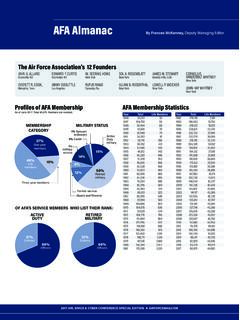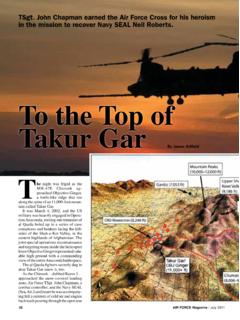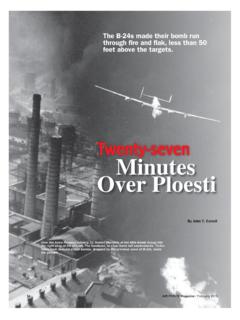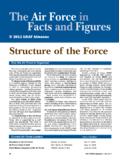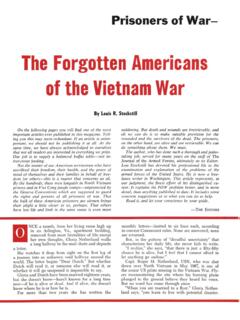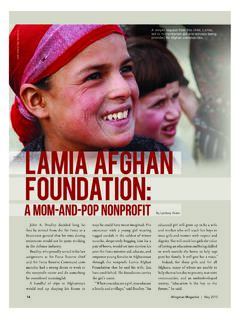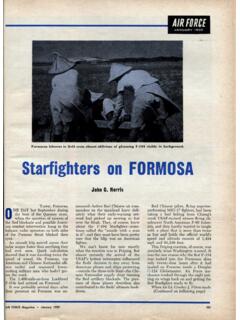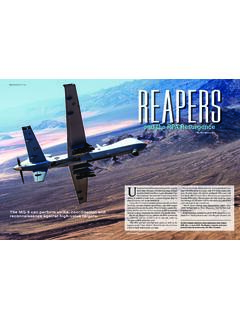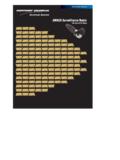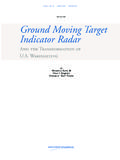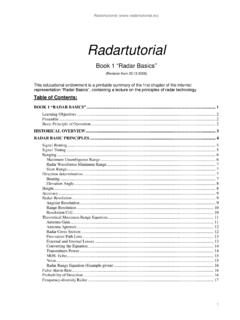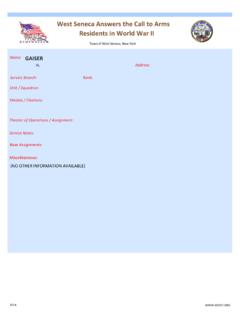Transcription of No US ground troop has been killed in an enemy …
1 AIR FORCE Magazine / June 201154 April 15, 1953No US ground troop has been killed in an enemy aircraft attack since the Korean Peter GrierAIR FORCE Magazine / June 20115455 AIR FORCE Magazine / June 201155 AIR FORCE Magazine / June 2011 The US Air Force is proud of the fact that no member of the American military s ground forces has been killed by an enemy air strike in more than half a century. It is an accomplishment officials have long believed speaks to the superiority of the American approach to airpower and the need to pay the price in money and effort to maintain that history can be a great teacher. Perhaps there is something to be learned about the approach necessary to keep this US record going by looking back at that last ground fatality.
2 The basic fact no US ground troop has been killed in an attack by an enemy aircraft since 1953 is frequently repeated by airpower advocates. It neatly captures the importance of both air superiority and the Air Force s skill in dominating the skies. But the details of that last success-ful enemy air attack are almost never mentioned. Who did it? What were the circumstances? What did the Air Force do in response?Turns out, those are not easy ques-tions to answer. However, it appears that two Army soldiers, not one, were killed in that successful enemy air raid. It was near the end of the Korean War, and it occurred on an island off the peninsula s west coast on what is today part of North Korea.
3 The attack was carried out by a propeller-driven North Korean light aircraft. In fact, it is highly possible, though not certain, the Army fatalities in question were due to a biplane at-tack from a Soviet-designed model that first flew in 1927. Asked for more details about the last soldier killed by enemy bombs, Air Force historians point to a passage about a particular attack in a classic book, The United States Air Force in Korea 1950-1953, by Robert F. Futrell, first published in 1961. Futrell writes about a strike that occurred on the night of April 15, 1953 about three months before the armistice that halted the Korean War. Based on the evidence we have, this is the last instance in which US ground forces sustained any deaths from enemy aircraft, says John Q.
4 Smith, director of the Air Force His-torical Studies Office. For nearly two hours before mid-night that evening, several communist aircraft attacked US forces based on Cho-do, an island in the Yellow Sea, off the North Korean coast. They killed two Army anti-aircraft artillerymen and destroyed an unspecified weapon. Four F-94s went to the area, but the Reds kept too low to show up in the ground clutter on the airborne radar scopes, Futrell the context of this passage, it is clear the attack in question was a so-called Bed Check Charlie raid. It is mentioned in a section Futrell devotes to these strikes, carried out by North Korean airmen flying light aircraft from airfields near the fighting front.
5 One or two North Korean aircraft would appear over a US ground unit after lights-out, flying low and slow, drop a few bombs, and leave. Often Bed Check Charlie flew a Po-2, a general-purpose biplane that for decades served the Soviet Union as a basic civilian and military trainer aircraft. Powered by a five-cylinder radial engine, the prototype Po-2 took to the skies in 1927. Mass production started shortly afterward and continued AIR FORCE Magazine / June 201156for decades, and to this day the Po-2 remains one of the most produced air-craft in Soviets turned the biplane into a night attack craft in the 1940s by outfitting it with bombs. A significant number ended up in North Korean hands after the end of World War II.
6 The Last Air AttackThe Korean War was notable as the first conflict in which jet aircraft played a major role, as US F-86s clashed with MiG-15s flown by Chinese and Soviet pilots in a fight to control the air. But in this context, the Po-2 biplane also served North Korean forces as an ef-fective weapon, and it countered the US edge in high s book does not specify what type of aircraft carried out the April 15, 1953, attack on Cho-do. But he notes that four Po-2s struck Cho-do in Octo-ber 1952, dropping bombs and strafing radar installations. Two Americans were wounded in this incident, and five Ko-rean civilians killed . Bed Check Charlie struck other locations using other piston light aircraft, including the Yak-18, a two-seat Soviet monoplane first used as a military trainer.
7 But it seems likely the last Army casualties due to enemy bombs were from an attack by an airplane with two stacks of wings. The little fabric-covered biplanesswere too elusive for United Nations night fight-ers, writes who were the two US anti-aircraft artillery person-nel killed by North Korean bombs on Cho-do that night? The island itself was an iso-lated outpost at the time. It is off the Korean coast, northwest from Seoul, part of the Taedong river estuary in North Korean the Korean War, UN naval forces controlled Cho-do and other offshore is-lands. These locations served as radar, radio, and electronic intelligence stations. Special operations units used them to stage raids on the mainland.
8 The occupation of these offshore islands .. was classified information at the time, writes historian David Rees in The Korean War: History and Tactics, published in was a constant target of North Korean harassment, including air raids. But anti-aircraft artillery was in short supply in the Korean theater, according to Futrell. US commanders could spare only one anti-aircraft battery for the island. A quick look through lists of US units deployed during the Korean War provides specifics: It was A Battery of the 933rd Anti-Aircraft Artillery (Au-tomatic Weapons) Battalion. Casualty lists maintained by the American Battle Monuments Commis-sion provide the names of two soldiers from the 933rd who were killed on April 15: Pfc.
9 Herbert Tucker, of Ocean, ; and Cpl. William R. Walsh, from Queens, It does not say they were killed by an air strike, but that is a logical conclusion.. Absolute confirmation of a claim like that can be tricky, says is thus likely, but not certain, that Tucker and Walsh were the last Army fatalities caused by enemy air action. Further evidence of this conclusion comes from an online unit memorial page for the 933rd maintained by the Korean War Project, a Dallas organiza-tion dedicated to collecting reference material about the conflict. It contains a lengthy missive from a former 933rd enlisted radio repairman named Albert Villanueva, a survivor of the attack in the night of April 15, 1953, Villa-nueva sat on a cot on the left-hand side of a tent on Cho-do island that he shared with fellow 933rd A Battery members, listening to the radio.
10 Villanueva was on the island because he had volunteered for the isolated post after learning that doing so would cut six months off his Korean tour of duty. Three months into his tour at Cho-do, and so far, things were pretty quiet, he remembered. The barracks tent was on the slope of a hill facing away from the North Korean mainland. Occasionally, he and his comrades would hike to the top of the hill and watch the North Koreans shell the village down on the beach. We were reckless to stand there and watch the shells land. The enemy never shelled us, though they could have easily raised their sights and fired away at us, he wrote in an account on the KWP in that April night, the radio was on because Villanueva had tired of A soldier keeps a look out while another grabssome rest in a foxhole in Korean Bed Check Charlie attackers often flew the Polikarpov Po-2, such as this one in Russian military markings.
